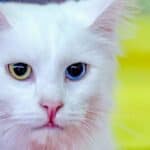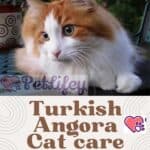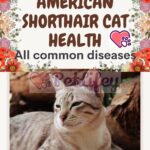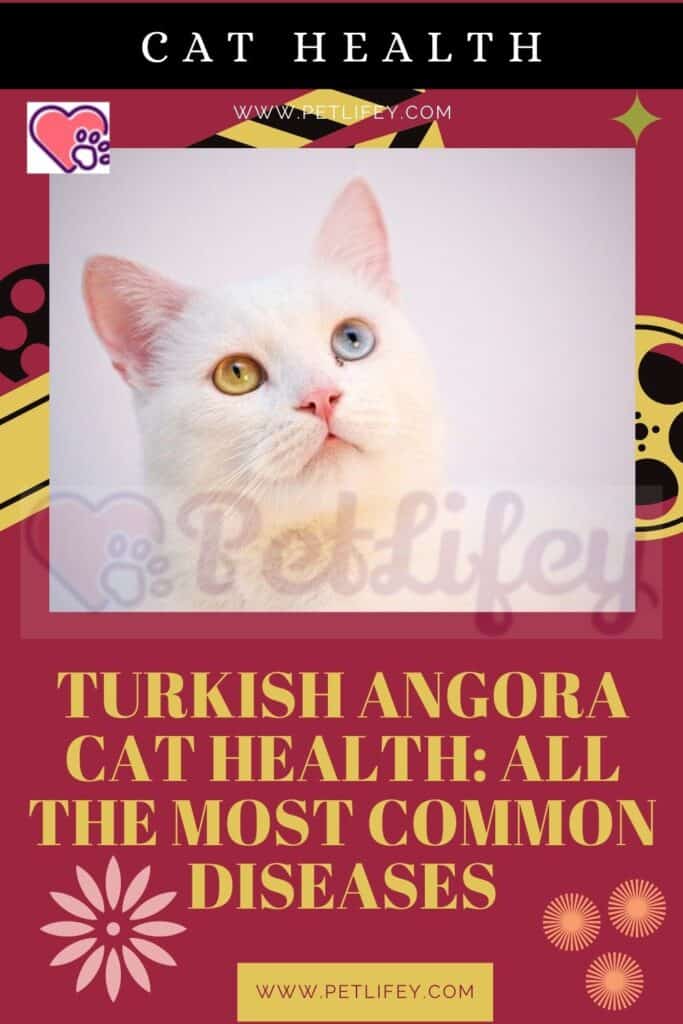
Diseases of the Turkish Angora, the most common pathologies in this cat breed. Let’s find out what they can be and how to recognize them.
In this article today we will shed light on the diseases of the Turkish Angora and all the main health problems that can occur during the life period, even quite long, of this elegant feline.
For this reason, if you have decided to adopt a cat of this breed, we advise you not to miss useful information about the diseases of the Turkish Angora.
Common diseases of the Turkish Angora
The Turkish Angora is a medium-sized cat, with a slender but very athletic and muscular body. However, despite its resistant aspect, this does not make it immune to common diseases.
Unfortunately, the Turkish Angora suffers from some diseases, which we will go on to explain below, which are also very serious.
Nevertheless, if the cat is well cared for, it can live safely up to 15 years of age.
Therefore, when dealing with the decision to adopt a cat, it becomes essential to know the particular attentions concerning the treatment and any diseases to which the animal may be subject.
Which is why in this article we are going to deal with the common diseases of the Turkish Angora.
The Turkish Angora is a rather robust cat, its medium-long fur and the little undercoat (which becomes more abundant on the neck and belly) allow it to resist both heat and cold well.
Precisely for this reason it seems to need no demanding care. Unfortunately, however, it is subject to particularly serious pathologies.
Below we will explain the most common diseases of the Turkish Angora. They can be the following:
- Genetic cerebellar abyotrophy : cortical cerebellar abyotrophy or cerebellar ataxia in the Turkish Angora cat, is due to a genetic defect that determines the degeneration of the neurons of the cerebellum which have an inhibitory and control function on movement. The evolution of the disease is very variable, in the most serious cases the animal in a short time is no longer able to coordinate, even unable to drink or eat; while in milder cases, the cat is not unable to move. Unfortunately there is no definitive cure for the disease, however the cat can be helped and supported, through physiotherapy and walking aids, at least as long as possible in walking.
- CGE or eosinophilic granuloma complex : affects the skin and mucocutaneous junctions or mucous membranes and is characterized by a particular clinical and histological picture. For this pathology there is a genetic predisposition to develop an “exaggerated” eosinophilic response towards specific antigenic stimuli. Furthermore, it can be hypothesized that this condition also derives from a delayed hypersensitivity reaction to various allergens. Generating severe itching in the animal which in turn causes licking, scratching, and self-trauma, which in turn predispose the cat to the development of secondary infections by bacteria and yeasts which aggravate the symptoms and the lesions themselves. Through the cytological examination of the material it will support the diagnosis. Once the diagnosis has been established, we will proceed with the treatment, starting with antiparasitic therapy and establishing a specific diet in order to exclude food allergies and intolerances. Furthermore, it will also be appropriate to analyze the possible existence of allergies caused by allergens present in the environment.
- Hypertrophic cardiomyopathy : This is the thickening of the ventricular wall in the cat’s heart. The increase in the thickness of the ventricular wall reduces the ventricular lumen and therefore can accommodate less blood, which no longer progresses will come back, creating congestive heart failure in the cat which has as a symptom pulmonary edema in the cat. The affected ventricles can be both right and left, making them stiff and inelastic. This problem occurs in cats aged 4 to 7 and has a family origin due to one or more mutations in a gene. Before diagnosing hypertrophic cardiomyopathy it is important to rule out other causes of thickening (hypertrophy) of the heart muscle, such as chronic hypertension, hyperthyroidism and aortic valve stenosis. The diagnosis is somewhat complicated, since the majority of cats with hypertrophic cardiomyopathy do not have any symptoms. Only through echocardiography will the veterinarian be able to observe the structure and dynamic function of the heart. Currently for treatment, no drug has been shown to be effective in slowing the progression of the disease. However, treatment of the primary disease can lead to complete resolution of the heart conditions.
- Obesity and diabetes : despite its agile, slender and muscular body, the Turkish Angora is a cat subject to obesity if it is not fed in the right way. Therefore, in order to maintain its elegant, long-limbed, strong and robust appearance, it will be necessary to control its diet and prevent it from finding itself in a situation of obesity in the cat. The Turkish Angora needs to consume daily meals based on animal proteins, which more than any other substance is able to transform into energy and minimize the amount of carbohydrates present in its diet. It also requires daily physical exercise, several games, scratching posts and high shelves to climb. It is good to know that the Turkish Angora has a particularly thin skeleton that would not support a body weight higher than the standard.
Other common diseases in cats
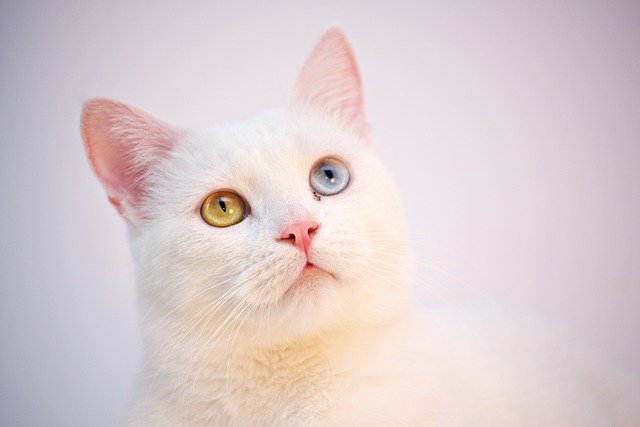
The diseases mentioned in the previous paragraph specifically concerned the Turkish Angora cat but there are other diseases that can generally affect all cats, and certainly the Turkish Angora is not immune.
They can be the following:
- Toxoplasmosis: Toxoplasmosis in cats is an infectious disease caused by the parasite Toxoplasma gondii, which finds its final host in the feline where it can reproduce;
- FeLV (feline leukemia): It is a disease caused by a virus of the Retrovirus family that affects the bone marrow. Transmission occurs through the exchange of blood and saliva, even if not direct. Fortunately, vaccination exists to prevent the problem in domestic cats;
- FIV: It is a feline immunodeficiency syndrome, caused by a virus similar to human HIV which, like the latter, affects the immune system of cats and causes immunosuppression. It is transmitted through saliva and blood. Unlike FeLV, there is no vaccine but if you intervene in time, you can extend the life of the cat;
- Allergies: Allergies that can affect the cat can be of various origins. It is essential to observe the animal scratching itself, sometimes even to the point of scratching itself, or licking itself with insistence, in order to understand that the cat is an allergic subject;
- Mycosis: It is a disease caused by fungi, which can cause redness, scabs and other symptoms that cause the cat to scratch constantly, with the risk of spreading the infection to other parts of the body. Mycosis can be transmitted by direct contact and in some cases the cat may not show symptoms but be a healthy carrier;
- Abscess: It is an infection that occurs when there are deep wounds on the cat’s body. We can observe them on the legs, behind the tail or on the muzzle of the animal;
- Conjunctivitis in cats : This is the inflammation of the mucous membranes of the eye to which the cat is very subject;
- Periodontitis : A disease of the cat’s mouth which, if not treated in time, can even be fatal. It particularly affects older cats;
- Otitis: It is the inflammation of the epithelium that covers the ear canal of the auricle. It occurs mainly in cats with low immune defences;
- Mange: It is also called scabies in cats and is caused by a mite of which there are several species and subspecies. It causes eczema-like symptoms: itching, scabs, patchy hair loss. It is transmissible to other animals and to humans.

